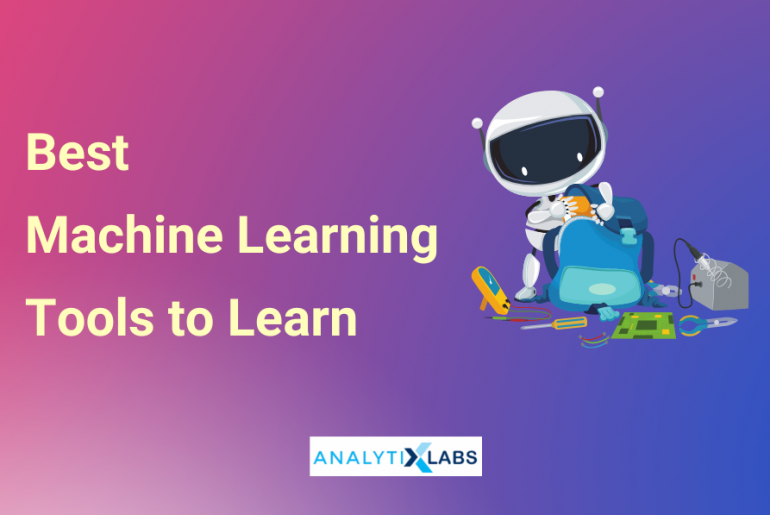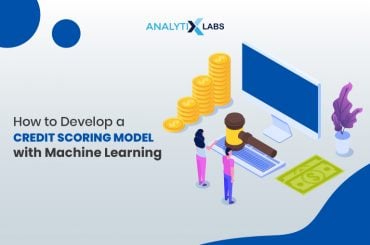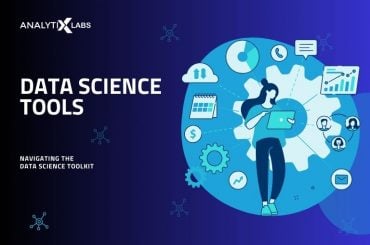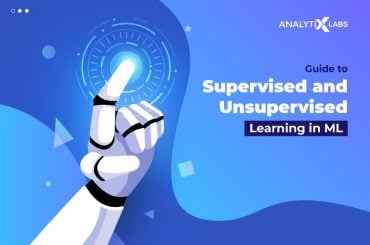AI and ML-based applications are exponentially growing post-pandemic. By 2025, the AI market is projected to grow from about 22.6 billion USD to approximately 126 billion USD. The AI Enterprise Applications market has the potential to reach 31 billion USD. Also, the funding and investment in AI-based startups across the globe can rise to over 38 billion USD.
The growing market and rising demand for AI-driven and machine learning products are creating a larger scope for AI Developers, ML Engineers, Data Analysts, and Data Scientists. Building AI-powered applications requires specific tech skills with efficiency to work on AI and ML tools, models, and frameworks.
We have covered details about machine learning and its types to assist you more precisely in leveraging machine learning tools. Online machine learning tools and techniques, with model training basics, have also been covered comprehensively.
What is Machine Learning?
Machine Learning (ML) is a sub-domain of AI that makes computers competent to learn from experiences like humans. It uses data, statistical methods, algorithms, and ML tools to analyze, develop models, and deduce accurate predictions (patterns, trends, etc.).
The core of AI lies in Machine Learning as it incorporates deep learning tools and neural networks to accelerate the ongoing advancements in Industry 4.0 and IoT.
Machine Learning vs. Deep Learning: Know how they are similar and differentML works on various algorithms that use mathematical and logical programs to forecast outcomes from the data set. These ML algorithms operate in three segments –
- Decision – Classifies labeled and unlabeled data to estimate the trend/pattern.
- Error Evaluation – Runs an error function to assess the model accuracy
- Model Optimization – Mitigates the differences to generate precise outcomes.
Here are some of the most common machine learning algorithm example for aspirants –
- Support Vector Machine (SVM)
- K-Nearest Neighbors (KNN)
- K-Means
- Naive Bayes
- Decision Tree
- Linear Regression
- Logistic Regression
- Random Forest
- Dimensionality Reduction
- Gradient Boosting
- AdaBoost
Types of Machine Learning
Undoubtedly, ML becomes quite complicated when dealing with diverse data sets.
Therefore, based on a particular goal, action, and result (in terms of data prediction), ML algorithms are classified into broadly four types –
Learn Machine Learning and AI on your own – A Step-by-step Guide1. Supervised Machine Learning
In Supervised Machine Learning, the data scientists train the model using labeled or known data sets.
Here, the label or known data means the input data is already mapped with the correct output data. When the input data undergo a supervised machine learning algorithm, it maps the fed input with the correct output.
Based on this direct execution, the algorithm determines the patterns and trends in data, learns from past-record observations, and makes predictions.
The data scientist corrects these predictions by making suitable adjustments and further executes the cross-validation process. The loop continues until the model delivers the outcome with high precision.
Machine learning algorithm example includes SVM, KNN, Decision Trees, Naive Bayes, Neural Networks, Random Forest, Regression – Linear, Logistic, Polynomial, Forecasting, etc.
Learn all about Linear Regression in Machine Learning2. Unsupervised Machine Learning
It is just the opposite of supervised learning. In Unsupervised Machine Learning, the data scientists train the model using unlabeled or unknown data sets.
Here, the input data is not mapped with the correct output data. Instead, the input data undergo an unsupervised machine learning algorithm, which determines the fed input’s hidden patterns, trends, and insights (without supervision).
Further, the algorithm applies the clustering process to group the data sets based on their similarities and differences. And the dimension reduction process to reduce the number of attributes.
After that, the model segments the data to study them in-depth.
It includes Principal Component Analysis (PCA), Singular Value Decomposition (SVD), Partial Least Squares, Fuzzy means, Apriori, Hierarchical, Probabilistic, and K-Means Clustering.
3. Semi-supervised Machine Learning
Semi-supervised Machine Learning is simply the amalgamation of both Supervised and Unsupervised Machine Learning. The model uses the small labeled data sets with sizable unlabeled data sets to determine the unknown data sets and label them.
- Classifies the data sets using Supervised ML algorithms.
- Extracts similar/distinct features using Unsupervised ML algorithms.
Further, the model utilizes the final data set as new input data to determine insights for making accurate predictions.
4. Reinforcement Machine Learning
Reinforcement Machine Learning is a trial-and-error-based behavioral ML process, more disciplined and feedback oriented. The data scientists train the model by reinforcing successful outcomes (set of final values, parameters, and actions).
The main goal is to develop the best and optimal framework. Like Supervised ML, it also –
- Learns from past-record experiences and observations
- Examines all potential alternatives
- Supervises and evaluates each prediction with high precision
Reinforcement ML includes three primary elements –
- Agent – Decision-maker
- Environment – Every single thing with which the agent interacts
- Action – The process in execution by the agent and the deliverables.
Machine Learning Tools With Their Features
1. Scikit-learn
Scikit-learn is a free machine learning software for all enthusiasts and is among the best machine learning tools and techniques. People who want to work with a large dataset for different mathematical models, including classification, regression, clustering, etc. Different models are explained easily with examples to understand with clarity.
It has a Python programming language library to support various ML codes. This is helpful for data analysis projects with top-notch technical support from NumPy, SciPy, and Matplotlib. Also, as an open-source platform, Sciki-learn is ideal for learning and commercial use.
2. PyTorch
For distinct projects on ML and NLP (natural language processing), PyTorch is a suitable open-source platform with the latest LUA programming language compatibility. As the name suggests, this framework combines Python language and Torch library.
It will be a seamless experience to work on a complex real-time project with various optimization algorithms, even on cloud platforms with a rich development ecosystem. Pytorch is easy to use for hybrid front-end and navigate through tools and extensions.
3. TensorFlow
This is a familiar name for JavaScript lovers to use as a training language for different ML models. However, it is a bit complicated compared to the previous tools, as the core programming language is JavaScript. But the good news is that any current model can be shifted here, as TensorFlow.js is a model converter.
It supports neural network building that makes ML projects much more effective. Also, it is easy to get community support as TensorFlow is a popular tool.
4. Weka
Weka is a comparatively less used machine learning software in the industry. However, this tool can contribute to data mining with crucial algorithms like classification, regression, clustering, and visualization. These algorithms can be applied directly to a project dataset or called from the user’s Java code.
WEKA is a suitable tool for students to learn from free training courses and get practical explanations of various relevant algorithms. Being a Java-based platform, usability increases for this platform as well.
5. KNIME
The last suggested tool in this list is KNIME, an impressive ML and data mining platform. Unlike the aforementioned tools, the best part is that they can be integrated with all the major programming languages, including C, C++, R, Python, Java, JavaScript, etc.
Different usabilities include business intelligence, financial data analysis, and CRM. It is a beginner-friendly tool to install, run, and make small projects. There are step-by-step pipeline features available for people with no programming background.
6. Colab
Colaboratory or colab is a helping hand for all programmers. It helps you to inscribe and implement Python in your browser. The main advantage of this is it requires nil configurations and can easily access GPUs freely without any hidden charge. Moreover, it allows easy sharing without facing any hindrances.
Colab notebooks let you blend executable code, rich text, graphics, HTML, LaTeX, and more in one document. Thus, it is a handy tool for all data scientists, AI researchers, and students.
7. Apache Mahout
Well, if you are looking for an open-source project or tool to develop scalable machine learning algorithms, then Apache Mahout is the solution. The main purpose of this tool is to help mathematicians, data scientists, and others execute their algorithms.
Mahout has multiple advantages, making them large firms like Facebook, yahoo, and many others. As a ready-to-use framework, developers may use Mahout to mine enormous amounts of data.
8. Accord.Net
The Accord.NET Framework is a fully C#-written .NET machine learning framework with audio and image processing components. It provides a comprehensive platform for creating professional-grade signal processing, statistics, computer vision, and computer audition applications, even for commercial usage.
It is free and permitted to use in any commercial application without a license. The framework provides many different probability distributions, kernel functions, hypothesis tests, and support for the most widely used performance evaluation methods.
9. Shogan
Shogan is a completely free and open-source tool built in a C++ module. It provides various data formats and techniques for machine learning issues. SWIG provides interfaces for Python, R, Ruby, Java, Octave, Lua, and C#.
Primarily, Shogan focuses on kernel machines. Moreover, it supports vector machines and helps in the classification and regression of problems. In a nutshell, we can conclude that it ensures the effective implementation of all types of ML algorithms. It also highlights the fundamental algorithms to make them clear and understandable.
10. Keras.io
Keras is a human-centric API. Keras is mainly used for lowering high cognitive loads. This, in turn, helps in providing standard simple APIs and proposes clear and responsive error signals.
The main advantage of this tool is that it can be deployed anywhere. Keras models may be exported to TF Lite for use on Android, iOS, and other embedded devices and JavaScript for direct browser execution. Additionally, serving Keras models using a web API is simple.
How to choose the right ML tool?
Choosing the most suitable one from various machine learning tools is a critical challenge. However, the following 5 step formula will help you to figure it out smoothly –
1. Classify the problem in the first place –
Study what type of data you have in the problem and classify it based on the –
- Input Data – Whether the given data set is Supervised, Unsupervised, Semi-supervised, or Reinforcement Machine Learning Type.
- Output Data – Whether the model’s deliverable is a regression (numbers), classification (feature extraction), or clustering (data grouping) type.
2. Thoroughly study your data –
For selecting the best machine learning tools, understand the data in depth, covering all aspects. It is the most underrated yet crucial prerequisite.
You must encompass the below 3-stage framework to dissect end-to-end –
- Use statistical, numerical, and visualization methods to analyze the data.
- From pre-processing to profiling and cleaning, entirely process the data.
- Apply feature engineering to simplify data transformations. Also, enhance the performance and precision of the ML model.
3. Discover the suitable ML algorithm –
Abstract the key insights from the above two research points and choose the appropriate algorithm considering the following selection criterion –
- How long will it take to develop, train, test, and deploy the model?
- How long will it take to deduce accurate predictions using the model?
- How will it work on the precision of the model?
- How will it evaluate the interpretability of the model?
- Whether the model will be scalable enough to accommodate changes?
- Whether the model will be able to meet the business goals?
- What complexities can be involved in the model & how will it reduce them?
4. Apply ML algorithms and conduct A/B testing
Clearly define the evaluation criteria, create a Machine Learning Pipeline, and apply the algorithms to it. The ML Pipeline must monitor and compare the performance of every algorithm on the data sets.
You can also A/B test the algorithm(s) on different dataset subgroups. To yield the optimum solution, execute this process periodically, significantly when new data adds to the model.
5. Conduct Hyperparameter Tuning or Optimization
Hyperparameter Tuning allows you to amplify the model’s performance. You can use it to reduce a predefined loss function and generate higher results with minimal errors.
It is vital for controlling the ML model’s behavior. Therefore, conduct it regularly, or the model will generate less optimal results.
Manual Search, Random Search, Grid Search, Bayesian Optimization, Tree-structured Parzen estimators (TPE), Halving Search (Grid and Randomized types), and HyperOpt-Sklearn are the top techniques.
Machine Learning Model Training
Machine Learning Model Training incorporates a comprehensive operation. In this, the ML algorithm learns from the proposed problem provided with the training data.
With the help of an algorithm’s recognizing factors and learning experiences, the machine learning model training generates the best outcome.
Here the outcome can be in different forms depending upon the business needs, such as:
- Fast processing of big data
- Analyzing data patterns
- Identifying trends and insights
- Detecting anomalies
- Examining correlations
Businesses utilize these outcomes to streamline end-to-end operations. As well as enforce better decision-making and predictive capabilities. They use ML to create a unique value proposition. It improves the customer success ratio and increases the overall revenue for the business.
What is Model Training?
Model training is an essential step in the development process for machine learning algorithms. Data scientists use various tools to find an algorithm’s best weights and biases to minimize its loss function over the prediction range. Loss functions are used to optimize machine learning algorithms. The types of loss functions used by data scientists can vary depending on the objectives they are trying to achieve and what kind or type of algorithm is being run.
The supervised and unsupervised learning techniques use mathematical representations to create relationships between data features and target labels. Being an essential step in machine learning, model training helps data scientists develop a working model that can be validated, tested, and deployed. It trains and analyzes the model’s performance to eventually determine its performance during application for the end-users. The model training outcome is highly dependent on training quality and algorithm choice.
Tools for Model Training
Here are the top ten machine learning model training tools for you to choose from based on your needs:
1. TensorFlow
Google’s TensorFlow is an open-source tool with a highly active worldwide community. It offers full control, allowing developers to train models from scratch. It even offers pre-built models that can be directly deployed for simple ML applications.
Dataflow graphs are a useful feature of TensorFlow for building NLP, computer vision, reinforcement learning, and predictive ML solutions.
2. PyTorch
PyTorch is a popular open-source machine learning tool supporting a robust ML library and tool ecosystem. It is easy to learn as it involves less code work and supports C++, Java, and Python.
The end-to-end machine learning framework of PyTorch is production-ready and cloud agnostic. Backed by an active community of researchers, it supports machine learning models for complex computer vision to reinforcement learning.
3. PyTorch Lightning
PyTorch Lightning allows developers to perform model training with speed and at scale. It supports multiple models to run parallelly on virtual machines. It deploys high-level wrappers upon PyTorch to allow research and customization while reducing redundancy.
Simplifying distributed computation PyTorch Lightning allows everything from running tasks on the cloud to hyperparameter optimization. It is intuitive and flexible, allowing developers to focus on performance.
4. Scikit-learn
Perfect for beginners and even experts, Scikit-learn is among the top open-source frameworks for predictive data analysis. It provides a wide range of classification, clustering, and regression models through high-level wrappers that support multiple algorithms.
Scikit-learn’s highly detailed documentation is easily readable and reusable in different contexts. It comes in handy for training ML models within a limited time and resources.
5. Catalyst
Research-oriented PyTorch framework, Catalyst facilitates rapid experimentation. It is built to meet the specific needs of deep learning models such as stochastic weight averaging, ranger optimizer, and one-cycle training.
Catalyst facilitates advanced research and development by saving source code and environment variables to support code reusability and reproducibility. It offers features like callbacks, model checkpointing, and early stopping.
6. XGBoost
XGBoost employs gradient boosting to achieve optimal model performance. It is a tree-based model training algorithm that uses an ensemble learning technique. Several tree-based algorithms run simultaneously to achieve an optimal model sequence.
Each new tree in the series improves on the weakness of the earlier version. XGBoost can handle large training datasets and supports parallel model boosting. It even processes combinations of numeric and categorical features.
7. LightGBM
Similar to XGBoost, LightGBM is also a gradient-boosting algorithm. It is a level higher than XGBoost in terms of performance. Using tree-based models, LightGBM handles large datasets much faster, thereby saving much training time.
Unlike other tree-based algorithms, LightGBM does not split the tree level or depth-wise. It uses a unique performance-boosting technique of leaf or breadth-wise splits. It utilizes low memory space and even supports parallel learning.
8. CatBoost
CatBoost is a popular and easy-to-use gradient-boosting algorithm. It reduces preprocessing efforts while optimally handling categorical data without much tuning. The salient features of CatBoost make it one of the fastest and most scalable model training tools.
CatBoost produces best-in-class results with low and high-volume data even with minimal training requirements. It is used for machine learning tasks such as ranking, classification, and regression for Python, R, C++, and Java.
9. Fast.ai
Fast.ai was developed to leverage transfer learning as a key strength of deep learning. It minimizes redundant engineering work by making deep learning accessible through an easy-to-use high-level interface.
Fast.ai has multiple wrappers and allows developers to focus on data intelligence. It offers deep learning accessibility across multiple languages and operating systems. You can enroll in their free online course for coders to better understand deep learning concepts.
10. PyTorch Ignite
Built as a wrapper on top of PyTorch, PyTorch Ignite works in conjunction with an ecosystem of machine learning integrations. Despite its easy-to-use interface, it allows the abstraction of model complexities and offers advanced research abilities.
With a high-level library, PyTorch Ignite helps flexibly and transparently train and evaluate neural networks in PyTorch. It involves less code than PyTorch while providing maximum control and simplicity.
Other model training tools
Besides the above-mentioned tools, you can pick from the other model training tools available in the market. Though these may not be popular, they may help you meet specific model training requirements. A few examples are:
- Theano is a great choice for delivering high speed with limited GPU resources
- Accord offers .NET and C# capabilities, along with a host of audio and image-processing libraries
- ML.NET is suitable for .NET developers allowing them to use C# or F# for building and training custom machine learning models
- Gensim is a great tool for NLP-specific models
- Caffe can help build computer vision solutions
FAQs
What are the tools in machine learning?
Machine learning is a branch of artificial intelligence where computers are taught how to learn independently by analyzing large amounts of data. Machine learning tools and techniques are algorithmic applications that enable systems to self-learn and improve without being explicitly programmed. Over time the machine learning software becomes accurate in predicting outcomes as more data is fed to it.
Which Python tool is best for machine learning?
ML tools make Python machine learning easy for data scientists. TensorFlow, Keras, PyTorch, Scikit-Learn, Theano, and Pandas are among the best Python tools for Machine Learning. However, based on its capability, you must pick the right tool to meet your specific machine-learning needs.
Which tool is best suited for solving machine learning problems?
Many online machine learning tools like TensorFlow, Keras, KNIME, PyTorch, Scikit-Learn, Weka, Theano, and Pandas help develop machine learning products and solve problems. They can be used depending on the project’s requirements. Common ML applications are spam identification, product recommendation, customer segmentation, image & video recognition, fraudulent transactions, demand forecasting, and sentiment analysis.
- Best Programming Languages for ML
- Importance of data processing in ML
- Understanding the basics of data veracity
- Descriptive vs. Inferential Statistics
- What is Data Acquisition in Machine Learning
- Best Python Libraries for ML
- Fundamentals Concepts of Neural Networks & Deep Learning
- What is Clustering in Machine Learning: Types and Methods
- An Ultimate Guide to Starting a Career in Machine Learning









1 Comment
Awesome blog